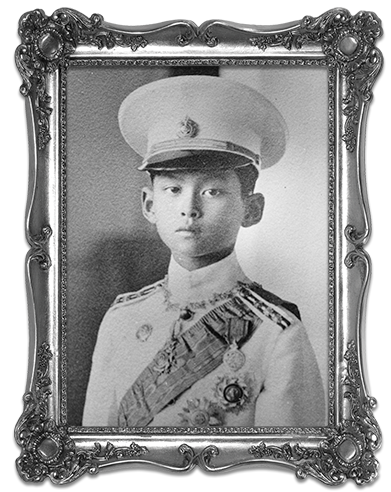
Prince Bhumibol Adulyadej
But in Siam, Mr Mahidol was known as Prince Mahidol Adulyadej, Prince of Songkla, and half-brother to King Prajadhipok, Rama VII. His wife was Mom Sangwan, a commoner who had won a nursing scholarship from Queen Savang Vadhana, the Queen Grandmother. The baby had two older siblings, Princess Galyani Vadhana, who was born in London, and Prince Ananda Mahidol, who was born in Germany.
The first home of Baby Songkla – the name on his American birth certificate – was a six-room apartment in Brookline, on the first floor of 63 Longwood Avenue, not far from Harvard University where his father, the prince, was studying medicine after having previously earned a certificate in public health.
By July the following year, the Mahidol family were ready to leave Boston, travelling home via London and Lausanne where the frail prince stayed a while to recuperate. It wasn’t until the end of 1928 that the family arrived in Bangkok. Queen Savang Vadhana, the Queen Grandmother, had arranged that Srapathum Palace be setup as their family home.
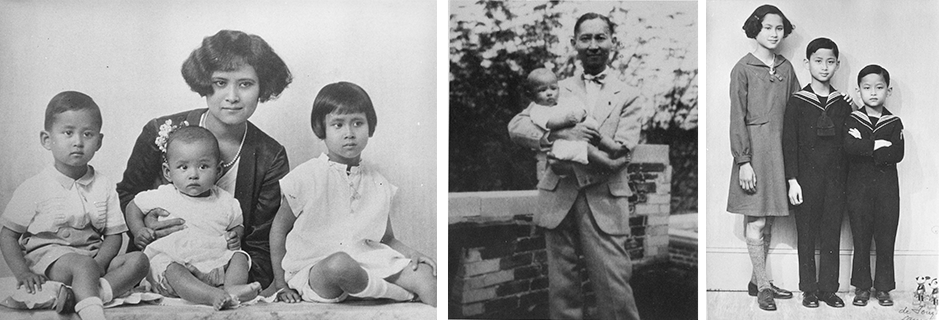 Family portraits of the Mahidol family.
Family portraits of the Mahidol family.
Royal protocol proved to be a hindrance to Prince Mahidol; after all, how could he practise medicine if he wasn’t allowed to touch his patient? The Prince decided to move to Chiang Mai to work at McCormick Hospital, run by the American Presbyterian mission. He planned to move his family up to Chiang Mai in due course.
But his illness took a turn for the worse, and he was diagnosed with amoebic liver abscess. He returned to Srapathum Palace where he spent the final days of his life until his death on September 24, 1929, from kidney failure. Prince Bhumibol Adulyadej was only two years old at the time.
The next four years were spent in relative stability, as Mom Sangwan held the family together in the grounded, down-to-earth manner that helped form the psyche of the three royal children. They first attended Mater Dei School, transferring subsequently to Debsirin School where the young Prince Bhumibol already showed a talent for music.
His penchant for jazz probably grew out of having listened to his father’s records, a collection of classical music and American jazz.
The period of normalcy was short-lived. On June 24, 1932, a revolution led by two Paris-educated men, Pibul Songgram and Pridi Banomyong, took control of Bangkok while the King was at Klai Kangwol Palace in Hua Hin. Rather than resist and risk “useless bloodshed”, King Prajadhipok relinquished his absolute powers for the country to become a constitutional monarchy. However, relations between the King and the government were less than smooth, and Queen Savang Vadhana decided it was in the best interest of her grandchildren – particularly Prince Ananda Mahidol who was frail of health - that they be sent overseas. In 1933, the Mahidol family settled in a modest apartment in Lausanne, Switzerland, and the children were enrolled at Ecole Miremont primary school.
 The young royals spent a happy childhood at Srapathum Palace with their paternal grandmother, the Dowager Queen Savang Vadhana (far right).
The young royals spent a happy childhood at Srapathum Palace with their paternal grandmother, the Dowager Queen Savang Vadhana (far right).
Even from an early age, Prince Bhumibol showed himself to be quite precocious and lively, with interests that ranged from sports, music, science and technology to carpentry and the arts. The bespectacled young prince displayed agility in various sports, including skiing, badminton and water sports.
But it was in the field of technology where Prince Bhumibol excelled, especially mechanics and electricity. When the Princess Mother inquired how her younger son was in the possession of a new toy, she discovered that it was a reward for fixing his nanny’s sewing machine. At the age of 10, he was able to build his own radio with metal coils he won at a school raffle, and a 10-franc investment to buy black ore to make a receiver for radio waves.
One of Prince Bhumibol’s childhood activities was to build a dam in a stream near their summer school on Les Pleiades mountain.
Music was another leisure activity for the young Mahidols. While Princess Galyani Vadhana played the piano, Prince Bhumibol started learning to play the accordion, but later switched to the saxophone when King Ananda opted out of a music lesson and pushed his brother into the room to take his place.
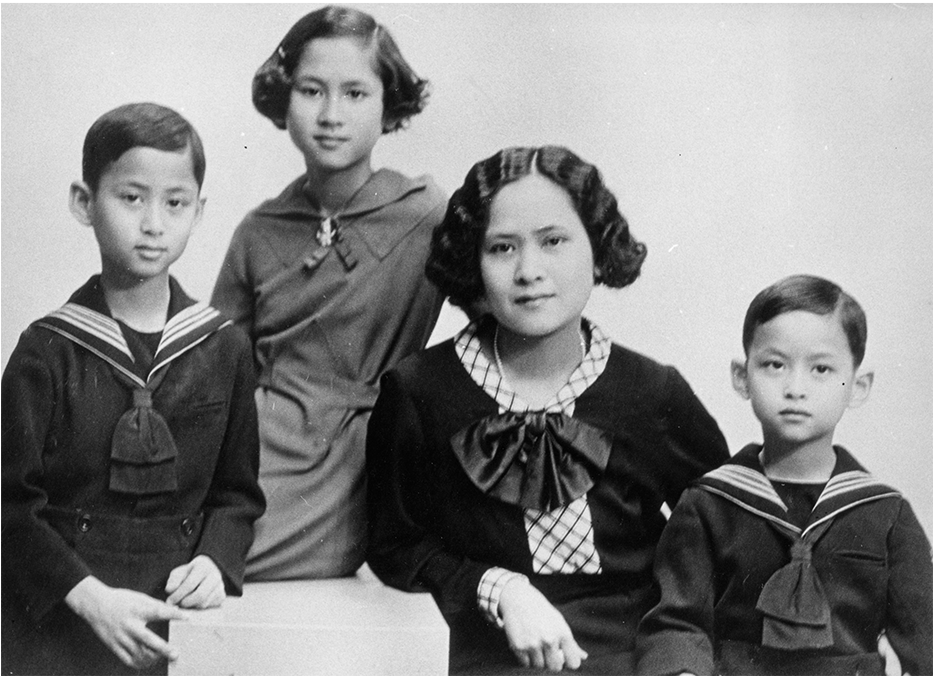 An official portrait of the Mahidol family, just after King Ananda Mahidol acceded the throne upon the abdication of King Prajadhipok in 1935.
An official portrait of the Mahidol family, just after King Ananda Mahidol acceded the throne upon the abdication of King Prajadhipok in 1935.
Life for the young royals changed on March 2, 1934, when King Prajadhipok, Rama VII, abdicated while he was in London, England. Following the Royal Laws of Succession, and with the blessings of Queen Savang Vadhana, the 9-year-old Prince Ananda Mahidol was name Rama VIII.
Against the wishes of the government, the Princess Mother insisted that the young king and his brother continue their schooling as normal instead of private tutoring. In a letter to Queen Savang Vadhana, the Princess Mother wrote: "…Having to shoulder the mantle of kingship, the king would be unhappy if deprived of his childhood… It is quite necessary for a king to mix and mingle with ordinary people to learn about their habits. By doing so, it would benefit the country, which is under a democratic system."
The two brothers were enrolled in a private school, Ecole Nouvelle de la Suisse Romande, where they learned Latin, French, German, English and Spanish as well as gardening and carpentry. At home they attended a Thai class, where they studied the language as well as Thai history and Buddhism.
Although they had moved into a more spacious home at Villa Vadhana in Pully, outside Lausanne, the Princess Mother made sure that they remained firmly grounded with chores and errands just like any other boy of their own age. They had to make their own beds, and were also encouraged to earn extra pocket money by picking apples and pears in nearby fruit orchards. Any indulgence to the king and his brother was discouraged except for special occasions like birthdays or the new year.
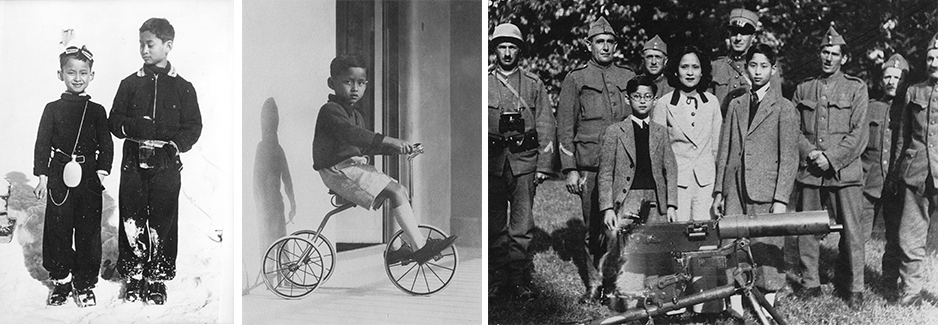 The young royals growing up in Switzerland
The young royals growing up in Switzerland
The Princess Mother also instilled in her children a sense of service to others. If they ever received monetary gifts, they had to put aside a percentage of it into a box for the poor. Similarly, punishment often came in the form of putting money into this box.
It is evident that the grounded upbringing and sense of responsibility instilled by the Princess Mother, as well as Prince Mahidol’s dedication to his country despite his own frail health, served to provide inspiration and a strong foundation that helped define the monarchy of the modern era as witnessed under the reign of King Bhumibol Adulyadej, Rama IX.
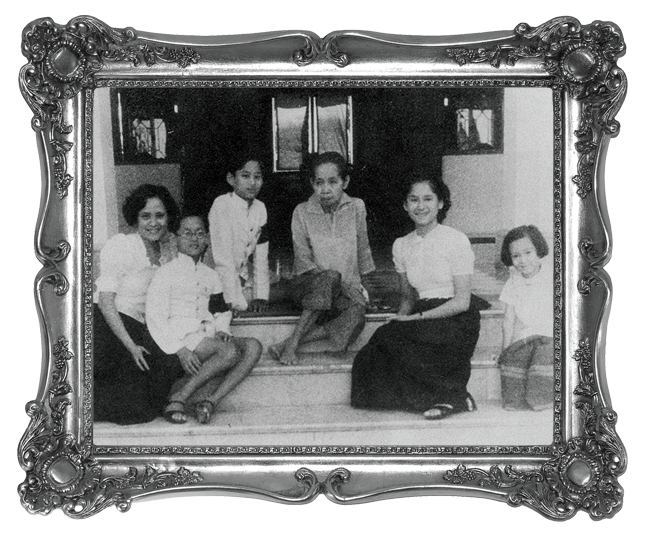
The Mahidol family visits the Dowager Queen Savang Vadhana at Srapathum Palace.
As a yet uncrowned king, King Ananda Mahidol was accorded a seven-tier umbrella. The pomp and ceremony must have bewildered the young king, who had up to now been making his own bed and picking apples, but the importance of his new status must have dawned on the young king when his own grandmother, Queen Savang Vadhana, prostrated herself before him within the confines of the Grand Palace.
During this short, two-month visit, one of King Ananda Mahidol’s formal duties was to elevate his mother to the rank of Somdet Phra Rajajonani Srisangwan – Her Royal Highness Princess Srisangwan the Princess Mother. In all the pictures that date to this period, the bespectacled Prince Bhumibol was always seen with the king, close by yet just a step behind.
The visit was all too short, and soon the young royals returned to Switzerland to resume their studies. As it turned out, Switzerland proved to be a perfect and safe environment for the family as World War II ravaged Europe and Asia.
 The royal brothers were never apart, and shared similar interests, whether it was model airplanes or battleship cannons.
The royal brothers were never apart, and shared similar interests, whether it was model airplanes or battleship cannons.
A private tutor, Cleon O Seraidaris, was a major influence in the lives of the two young royals during this period, taking them cycling and rowing, tinkering with electric trains, model ships and aircraft, electrical gadgets and radios, inventing board games and woodworking.
A jazz band at a hotel in Arosa inspired Prince Bhumibol to take up jazz music, and soon they had bought their first saxophone, a second-hand instrument that cost 300 francs, for which they had to pay half out of the pocket money, with the Princess Mother chipping in the other half. The jazz band at the same hotel in Arosa also served to fuel Prince Bhumibol’s fascination for New Orleans style jazz music. It was a passion that all three Mahidol children shared.
Upon completing high school, Prince Bhumibol received a baccalaureate majoring in French literature, Latin and Greek. He applied to study science at the University of Lausanne, while King Ananda studied law. As an indication of her love of acquiring knowledge, the Princess Mother also took courses at the university, with philosophy, French literature, Pali and Sanskrit being among her choice of subjects.
Soon, Villa Vadhana had its own jazz band, the Wong Krapong (Tin Can) Band, which offered impromptu sessions for friends and Thai students in Switzerland who gathered there regularly. This was a precursor to the Aw Saw Band which was set up much later at Chitralada Villa in Bangkok by King Bhumibol.
The relative normalcy of life in Lausanne was a stark contrast to the rest of Europe. On May 30, 1941, during the height of the Blitz in London, King Prajadhipok, Rama VII, died of heart failure. He was cremated in a private service in Golders Green Crematorium.
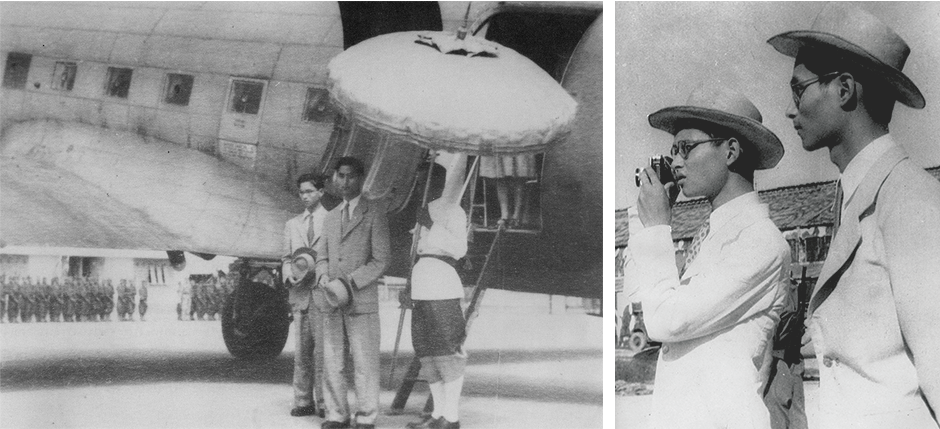 During King Ananda Mahidol’s visit to Thailand in 1946, he was constantly accompanied by his younger brother, Prince Bhumibol Adulyadej, who was already an avid photographer.
During King Ananda Mahidol’s visit to Thailand in 1946, he was constantly accompanied by his younger brother, Prince Bhumibol Adulyadej, who was already an avid photographer.
In December 1941, almost simultaneously with the invasion of Pearl Harbour, the Japanese invaded Thailand, and despite an attempt at repelling the forces, the country was inadvertently drawn into the conflict as a Japanese alliance under the premiership of Pibul Songgram. However, the formal declaration of war on the US was never delivered, as the Thai ambassador to the US, MR Seni Pramoj, formed the underground Seri Thai (Free Thai) resistance movement, with finance minister Pridi Banomyong becoming the secret head of the movement within the country, assisting British and American intelligence agents to operate in Bangkok. As a result, when the war ended in 1945, Thailand was not treated as an enemy collaborator with the Japanese.
The day Prince Bhumibol turned 18 on December 5, 1945, the Mahidol family arrived back in Bangkok, landing at Don Muang International Airport in a British Air Force plane. During this trip, King Ananda Mahidol made his first visit to Bangkok’s Chinatown, with Prince Bhumibol acting as his brother’s official photographer.
Photography was not Prince Bhumibol’s only passion during this period; the prince also began composing jazz numbers in collaboration with Prince Chakrabandhu who had been a regular at the musical soirees at Villa Vadhana in Lausanne. Most of the King’s much loved compositions were composed during this time, from Candlelight Blues and Love at Sundown, to Falling Rain and H.M. Blues.
The family's planned return to Switzerland never took place, as King Ananda Mahidol was tragically and mysteriously killed by a gunshot to the head on June 9, 1946, in his bedchamber at Borombiman Mansion in the Grand Palace compound. Suddenly and unexpectedly, Prince Bhumibol found himself King.
After three months of mourning, King Bhumibol prepared to return to Lausanne to resume his studies, changing the course of subjects from science to law and political and social sciences which would be better suited to his new role as monarch. On the day of his departure in September 1946, the King’s convoy was surrounded by crowds of people hoping to catch a glimpse of their new monarch.
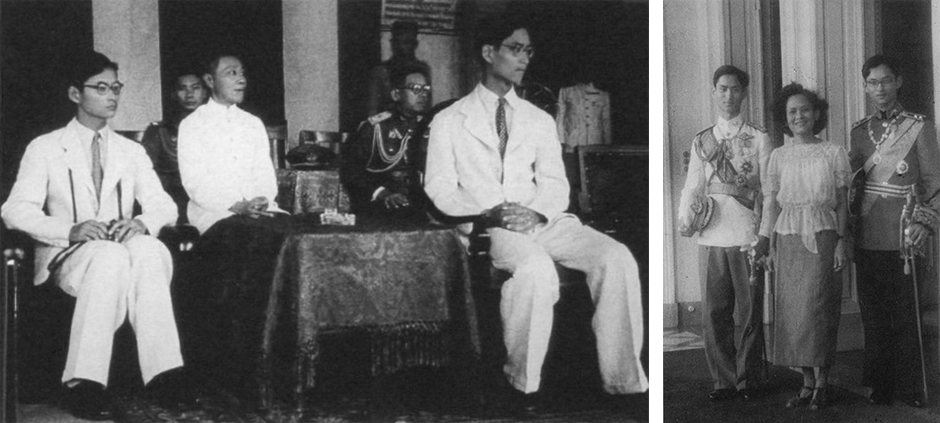 King Ananda Mahidol and Prince Bhumibol Adulyadej with HRH the Princess Mother.
King Ananda Mahidol and Prince Bhumibol Adulyadej with HRH the Princess Mother.
"Please do not abandon the people," shouted a voice above the crowd. Recalling his experiences of the day, the King later remarked: "I felt like shouting back 'If the people do not abandon me, then how can I ever abandon the people?'"
Perhaps this voice helped to inspire the King to dedicate himself to his people throughout his long and eventful reign, lasting almost 70 years, and making him the longest reigning monarch in modern history.
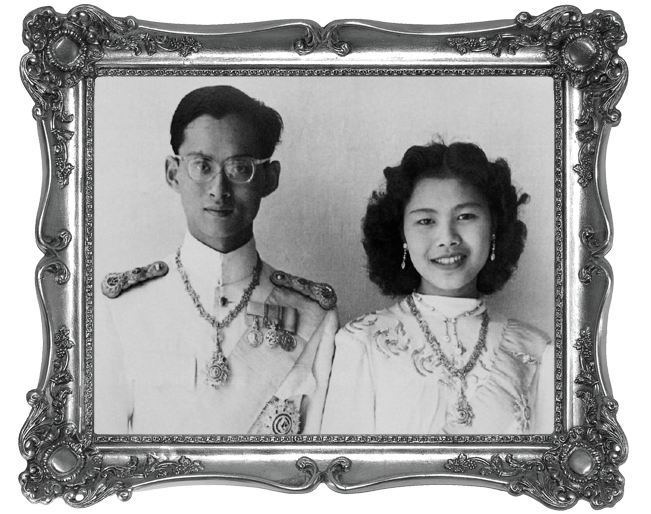
Wedding portrait of Their Majesties the King and Queen.
The King had previously met Mom Rachawongse Sirikit Kitiyakara, daughter of the Thai ambassador to London, Prince Nakkhatra Mangala Kitiyakara, but romance did not develop until the King was involved in a serious car accident which resulted in the loss of his right eye. The King’s convalescence in Lausanne was made all the more bearable with the constant presence of MR Sirikit, whose parents had now enrolled her at a boarding school in Lausanne.
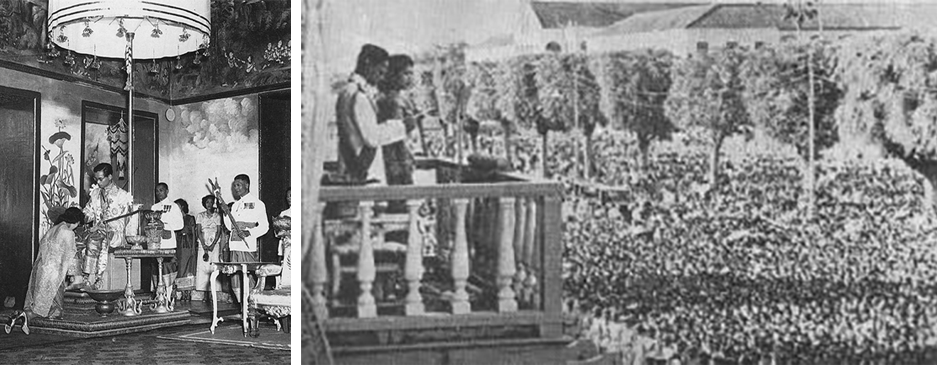 His Majesty the King elevates MR Sirikit to the rank of Queen.
Their Majesties the King and Queen make their first public appearance after the coronation ceremony.
His Majesty the King elevates MR Sirikit to the rank of Queen.
Their Majesties the King and Queen make their first public appearance after the coronation ceremony.
On August 12, 1949, the day MR Sirikit turned 17, the couple announced their engagement.
In February 1950, the couple returned to Thailand. The joy of the royal romance was overshadowed by the solemnity of the task at hand – the royal cremation of King Ananda Mahidol, which took place on March 29.
A month later, on April 28, the royal wedding took place at Srapatum Palace, presided over by Queen Savang Vadhana, the Queen Grandmother.
 Queen Savang Vadhana anoints the forehead of MR Sirikit at part of the wedding ceremony at Srapathum Palace.
Queen Savang Vadhana anoints the forehead of MR Sirikit at part of the wedding ceremony at Srapathum Palace.
This was followed a week later by the Coronation at the Grand Palace, during which he swore: "We shall reign with righteousness, for the benefit and happiness of the Siamese people." As part of the day’s ceremonies, his new wife was elevated to the rank of full queen.
Not long after, the royal couple departed once again for Switzerland where the King resumed his medical treatments, and finally returned to Thailand permanently after the birth of their first child, HRH Princess Ubolratana Rajakanya, in 1951.
The King’s task now was to establish a role for the constitutional monarchy, in a country that had not seen a king in permanent residence since 1935 when King Prajadhipok, Rama VII, abdicated. The political scene during the early 1950s was looking bleak as the military rule of Field Marshal Pibulsonggram jockeyed for power against the royalist Democrat Party under Mom Rajawongse Seni Pramoj.
Acting as his staunch supporter and setting the tone for the new king’s vision for his country was none other than his mother, who had always instilled in him a sense of selflessness, and the values of helping others less fortunate.
Another person of influence could have been his father’s former friend and confidant, Francis Bowes Sayre, whose letter to the young king offered a clear vision for his role, and way to deal with the murky political situation.
 The arrival of the young prince and princesses soon completed the royal family.
The arrival of the young prince and princesses soon completed the royal family.
"To meet such problems, your own course will be clear. You will follow the pathway which your father always followed, the pathway of selfless service for his country and its people. Your ideals, like his, must be kept untarnished and shining, and your constant compass if you would avoid shipwreck must be utter goodness and integrity of character. Nothing else will so surely win your people’s hearts and strengthen your reign."
During the early years of his reign, the King was already finding ways to help improve the livelihood of his people. When the royal family moved from Amporn Palace to Chitralada Villa, Dusit Palace, the palace grounds gradually became an experimental ground for various projects that was funded through the King’s own private purse.
Realising that his people were suffering from malnutrition, he experimented with fish breeds, even turning his swimming pool into a fish pond to raise Tilapia mosambica so that the rural poor could have an easy source of protein. The best of breeds were presented to government officials and farmers for further breeding.
From this grew the Royal Chitralada Projects, which aim to serve as models for the agriculture sector. This would soon include demonstration forestry, experimental rice fields, milch cow farming, biogas production, crop planting, a dairy farm, milk centre, experimental rice mill, rice husk grinding and compressing plant, fruit juice plant, the Suan Dusit powdered milk plant, milk-pellet plant, cheese plant, and alcohol distillation plant for fuel research.
The family also grew, with the addition of HRH Prince Vajiralongkorn in 1952, HRH Princess Sirindhorn in 1955, and HRH Princess Chulabhorn in 1957.
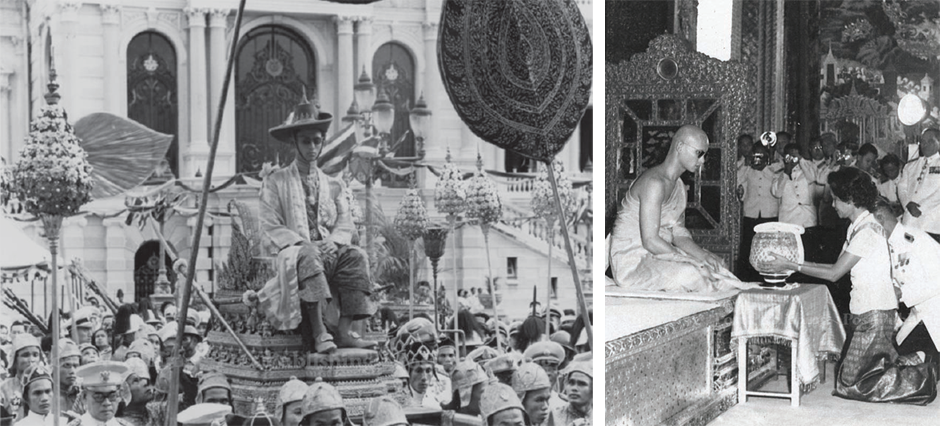
His Majesty the King was ordained as a monk, fulfilling the traditional rite of the Thai male.
In 1955, Their Majesties the King and Queen made their first visit to Thailand’s impoverished northeastern region, the first monarch of the House of Chakri to do so. The trip covered 14 provinces and 19 days, and was the beginning of a tradition of upcountry visits to remote areas that was to continue throughout most of the reign.
In December 1955, the Queen Grandmother, Queen Savang Vadhana, passed away at the age of 93, and following her cremation in the following year, King Bhumibol Adulyadej entered the monkhood according to Thai tradition. The ordination took place in the Temple of the Emerald Buddha on October 22, 1956, and during his 2-week stay in the monkhood, the King, now known by his monastic nomenclature as Bhumibalo Bhikku, resided at Pan Ya Villa, Wat Bowon Niwet. Here, his spiritual guidance for dhamma studies and vipassana meditation was Phra Sobhaganabhorn, who was later to become the Supreme Patriarch. He made regular morning alms rounds walking barefoot around the community to allow the public to make merit.
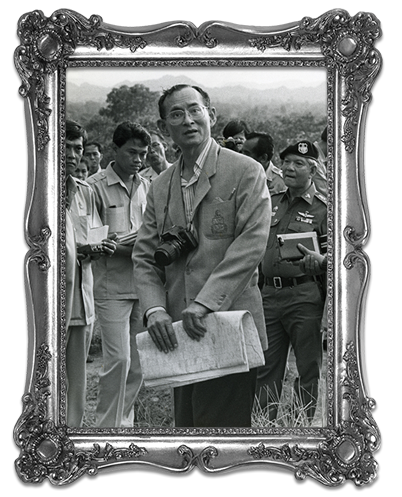
His Majesty was hardly ever without his working tools – a camera and a map - during his visits to the people.
The first of these trips was to Vietnam in 1959, followed by Indonesia and Burma, in 1960. Their Majesties embarked on a month-long visit to the United States, followed by a lengthy visit to 14 European countries.
The impact of these visits was enormous, and hugely beneficial to the country. Born and raised overseas, His Majesty the King was at ease in the foreign environments, and spoke in English, French and German on various occasions.
Though Her Majesty the Queen was more nervous and less vocal on these extended trips, particularly during media interviews, she attracted the world’s attention for her beauty, poise and glamour. Wearing a combination of western outfits designed by Pierre Balmain and Thai outfits which she had specifically compiled from ancient archives, this led to a revival of Thai costume as well as local hand-woven textiles, which had gradually become a dying art due to the influx of cheaper factory-produced printed fabrics.
The visits were also strategically beneficial to the country’s well-being, particularly during the Cold War. As noted by the foreign minister, Thanat Khoman: "The underlying objective of His Majesty’s state visits was to make Thailand known internationally and to seek Western support in countering the spread of communism that was a threat to our national security."
His visits to rural Thailand had started a few years earlier, with an extended trip to the northeast of the country in 1955, the first time a Thai monarch had visited this region. He returned to Isan in 1958, and in the following year he travelled to the South. These trips to remote corners of the Kingdom became a trademark of His Majesty’s reign, and historical photographs today often show the monarch making his way over rough terrain by car, by boat and even on foot, to visit his people, and gain a first-hand experience about their woes so he could find a way to help them. His tools of trade were a camera, a self-produced map and a pencil. With these tools and his talks to village elders and farmers, he began to gain a full perspective of his country that was a far cry from the mountains of Lausanne where he had spent most of his childhood.
He was to spend up to eight months of the year travelling upcountry, using his regional palaces – Bhubing Palace in Chiang Mai, Phu Phan Palace in Sakon Nakhon, Klai Kangwon Palace in Hua Hin and Thaksin Ratchaniwet Palace in Narathiwat – as his bases. With his deep understanding of the problems and the geography, as well as the cultural differences of each locality, he gradually formulated his own remedies that would improve their well-being and livelihood, more than any government has ever been able to do for its citizens.
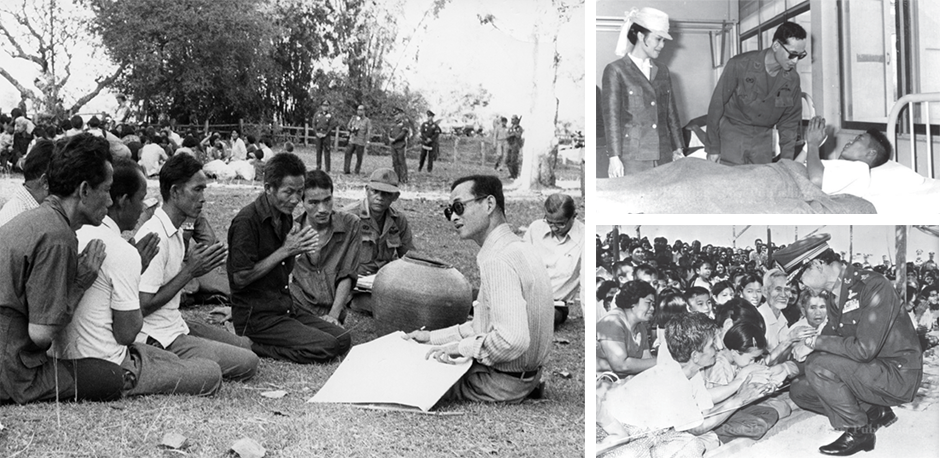 His Majesty spent much of the year travelling to the far corners of the Kingdom to visit his people and find ways to improve their livelihood.
His Majesty spent much of the year travelling to the far corners of the Kingdom to visit his people and find ways to improve their livelihood.
As part of his plan to help his people, His Majesty started dedicating himself to agricultural experiments and demonstration projects within the grounds of Chitralada Palace to improve the well-being of his people. Since 1961, his projects emphasised the use of optimum utilisation of natural resources and simple, accessible methods backed by scientific and technological research with the ultimate goal to help villagers gain self-sufficiency and long-term improved well-being.
Among the non-profit projects introduced within this one square kilometre of palace grounds are fish breeding – the palace swimming pool was originally turned into a spawning pool when this project first started – demonstration forestry, experimental rice fields, milch cow farming, biogas production and crop planting. Semi-commercial projects where profits are returned to the business for expansion include a dairy farm, milk centre, experimental rice mill, rice husk grinding and compressing plant, fruit juice plant, the Suan Dusit powdered milk plant, milk-pellet plant, cheese plant, and alcohol distillation plant for fuel research.
No other palace in the world can boast such an enterprise.
Another royal initiative of His Majesty the King in support of agriculture was the revival of the ancient Royal Ploughing Ceremony. Dating back to the Ayutthaya period, the ceremony had been discontinued just after the revolution to abolish the absolute monarchy, but it was held once again in May 1960 to ensure sufficient rainfall and an abundant harvest, and forge links between farmers and the monarch on a symbolic level.
Despite his heavy schedule, His Majesty found time to pursue some of his own artistic passions during this period, most notably his music, which had always been an integral part of his life since his days in Switzerland. This aspect of his life probably gave him the necessary balance to the pressure of his duties as a monarch.
In the early 1950s His Majesty set up the Lai Khram (Vintage) Jazz Band which would perform on the Aw Saw (the initials of the Ambhorn Satharn Palace where the King first resided) radio station. The band’s name was later changed to Aw Saw Band, and the King would jam live with the band for the radio broadcast every Friday, becoming known as the Aw Saw Friday Band.
This decade was also one of His Majesty’s most prolific in terms of musical compositions, writing more than 15 songs from his entire body of 48 songs within the 10-year period. During his visit to the US, he jammed with the likes of Kenny Alford and His Dixie Cats, Benny Goodman, Jack Teagarden, Lionel Hampton and Stan Getz.
The Hockschule fur Music and Darstellende Kunst (Academy for Music and Performing Arts) in Austria also presented His Majesty with an Honorary Membership, the 23rd person and the first Asian to receive this honour.
 His Majesty the King pursued such passions as music, sailing and painting.
His Majesty the King pursued such passions as music, sailing and painting.
Parallel to his music was his body of art works, which seemed to flourish during this brief moment only to be put aside to make way for more pressing responsibilities. His gift for painting was probably inherited from his father, Prince Mahidol, who would have chosen to study art if he could have followed his heart. He painted in both realistic and abstract styles, his favourite subject being Her Majesty the Queen. One can sense a great deal of intensity in his work, and he once remarked in an interview to Geo magazine: "This is called ‘Subversion’ – there is greed, anger and evil … I painted it with a knitting needle. And this is called ‘Red Hand’. I did it once when I had a fever from pneumonia … Every artist has a feeling of being crammed in and every artist wants to explode."
Another means to release the pressure from his responsibilities was sailing and building dinghies. His first boat, a two-man Enterprise design built in 1964 in the grounds of Chitralada Villa, was called Rajpatan (Royal Design). It was in this boat that he beat the Duke of Edinburgh in a race from Pattaya to Koh Larn.
His second was an OK-class dinghy name Vega, which he sailed single-handedly across the Gulf of Thailand from Hua Hin to Sattahip, a trip of 64 nautical miles which took 16 hours to complete.
His Majesty’s sailing honours were capped by a joint gold medal with his daughter, Princess Ubolratana, at the 1967 Southeast Asian Peninsular (SEAP) Games in Pattaya.
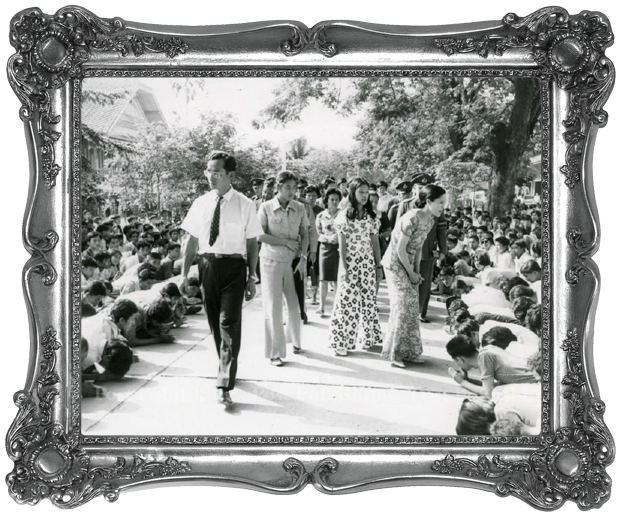
The royal family visits the students who took refuge in the grounds of Chitralada Villa during the political turmoil of October 1973.
One of His Majesty the King’s most prominent projects initiated during this period was the Royal Project, which was created after His Majesty visited the hill tribe village of Doi Pui in 1969. Though only a short distance from the city of Chiang Mai, the mountainous area was devoid of forest cover which had been destroyed by Hmong villagers through their slash and burn cultivation of opium poppies. This form of livelihood was not only creating the social problems of heroin addiction and crime syndicates, but also bringing in more money to the drug kingpins rather than the growers themselves, who remained dirt poor.
In an attempt to halt this vicious cycle of crime, drugs and deforestation, His Majesty proposed the planting of peach trees to replace opium poppies. A variety had been found that thrived in northern Thailand, and villagers were soon convinced that this new crop would help improve their earnings. The Royal Project soon encompassed health care and education for the villagers, helping to raise the quality of life and bring in an improved and steady income for their families.
The project gradually expanded to include other temperate crops such as apples, strawberries and Arabica coffee, flowers as well as livestock. It was registered as a foundation in 1992, and has received several international awards including the Ramon Magsaysay Award for International Understanding in 1988.
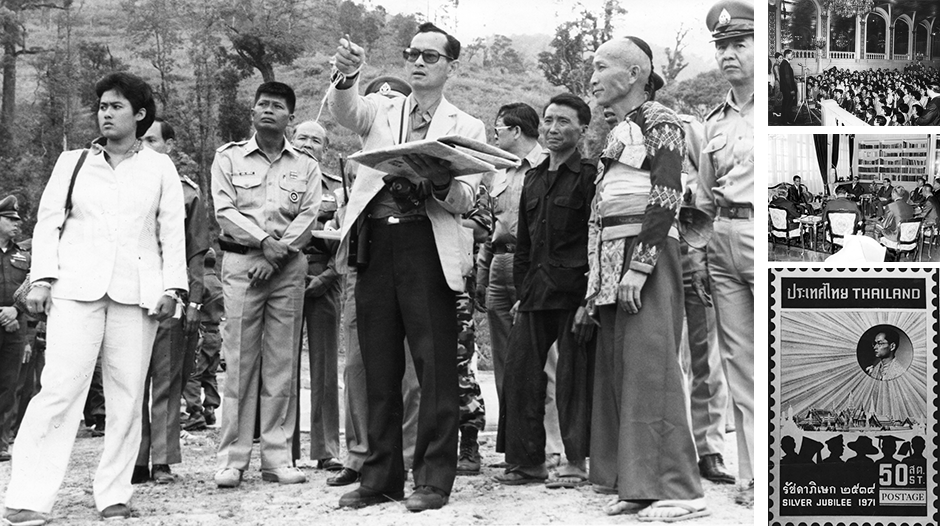 The Royal Projects helped hill tribe villagers replace opium crops with commercially viable crops such as peaches, apples, strawberries and Arabica coffee.
A commemorative stamp for the Silver Jubilee, 1971.
The Royal Projects helped hill tribe villagers replace opium crops with commercially viable crops such as peaches, apples, strawberries and Arabica coffee.
A commemorative stamp for the Silver Jubilee, 1971.
On June 9, 1971, His Majesty the King celebrated the 25th anniversary, or the Silver Jubilee, of his accession to the throne, an event which was marked with great celebrations throughout the city.
In 1972, when HRH Prince Vajiralongkorn had come of age, His Majesty formally designated him as Heir Apparent through a traditional ceremony held in the Ananta Samakhom Throne Hall, making him the third crown prince since the beginning of the Rattanakosin period after Crown Prince Maha Vajirunhis, who passed away at the tender age of 17, and Crown Prince Maha Vajiravudh, who went on to become King Rama VI.
Two major political upheavals stood out during this decade of His Majesty the King’s reign. First was the student uprising of October 14, 1973, when students protested en masse against the dictatorial rule of the prime minister, Field Marshal Thanom Kittikachorn, his deputy prime minister Field Marshal Praphas Charusathien, and Field Marshal Thanom’s son, Col Narong Kittikachorn.
The situation turned violent, as security forces opened fire on the crowds, prompting His Majesty to open the gates of Chitralada Villa to allow fleeing protesters to seek refuge within the palace grounds. His Majesty personally walked around the palace grounds to meet the demonstrators, then appeared on national television to announce the appointment of an interim government led by Prof Sanya Dharmasakti.
The second incident was linked to regional politics of the mid-1970s, as one by one, the countries in the Indochina peninsula fell to communist forces. In April 1975, Phnom Penh was taken by the Khmer Rouge under Pol Pot, and years of genocide followed. Saigon fell to North Vietnam and was renamed Ho Chi Minh City. The monarchy in Laos came to an end when the Pathet Lao took control of the country.
People feared that Thailand would be the next domino to fall. The Communist Party of Thailand (CPT) had started a series of agitations within the country, and several ultra right-wing groups were created to oppose this movement. Violent clashes occurred regularly, and the situation was exacerbated by the return of field marshals Thanom and Praphas from their exile.
On October 6, 1976, military forces assaulted student protesters at Thammasat University, spurred by a student re-enactment of an earlier hanging of two activists in Nakhon Pathom. The brutal attack caused many students to flee into the jungles to join CPT strongholds. A subsequent coup brought down the government led by MR Seni Pramoj, and a few days later, Prof Thanin Kraivixien was appointed prime minister.
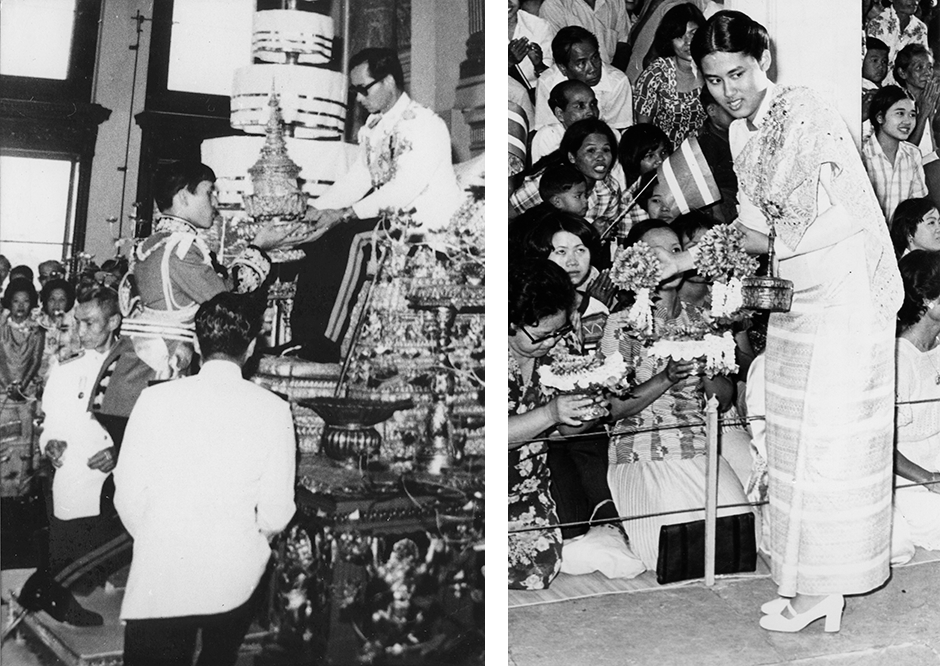
Amidst this atmosphere of conflict, there was some cause for celebration early the following year when HRH Crown Prince Maha Vajiralongkorn wed ML Soamsawali Kitiyakara, on January 3, 1977.
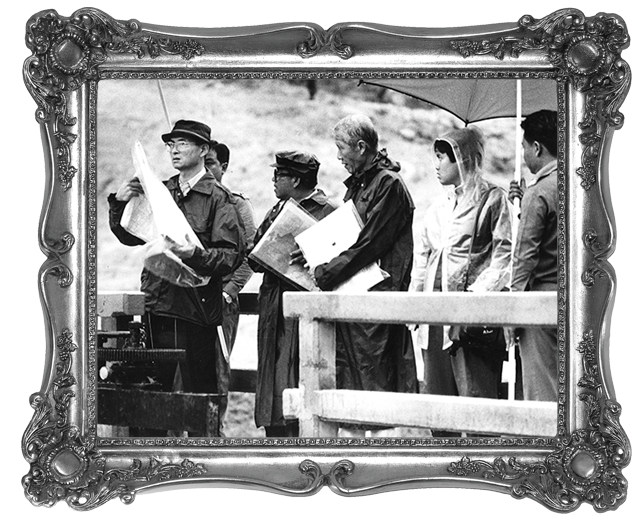
jesty the King was often accompanied by HRH Princess Maha Chakri Sirindhorn who acted as His Majesty’s personal assistant on the royal development projects.
Despite severe bouts of illness, His Majesty was working harder than ever, extending his upcountry visits long into the night, and often working on alone through the night studying and analysing data to find the best course of action while his entourage rested. He often drove his own car or walked on these visits in order to better understand the terrain.
His understanding of localised problems came from listening to the villagers. "Villagers are your teachers," His Majesty explained. "You must learn from them first, about their way of life and culture, and then use your knowledge to complement the work, and in advising them."
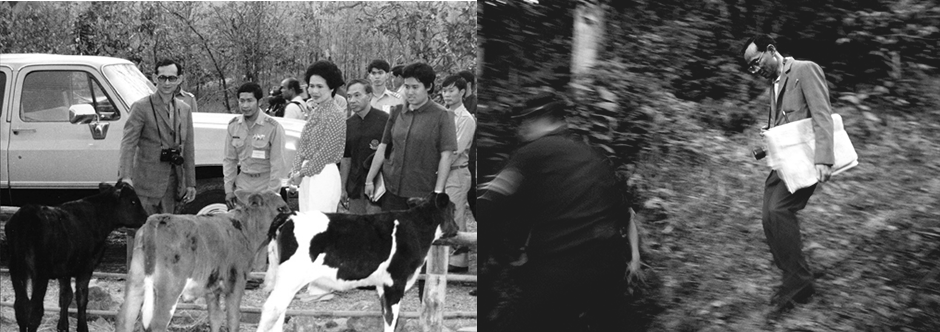 Often travelling on foot through dif cult terrain, Their Majesties visited all the remote corners of the country and initiated development projects to help the people lead sustainable lives.
Often travelling on foot through dif cult terrain, Their Majesties visited all the remote corners of the country and initiated development projects to help the people lead sustainable lives.
In 1979, the first of many "Living Museums" was opened at Khao Hin Son, Chachoengsao province, as a research and development centre. "These centres are like natural living organisms," His Majesty once explained. "They actively demonstrate the conclusions of development research and model ways that people can adapt our findings and use them to make a living."
Khao Hin Son’s rugged and rocky terrain served as a model for restoring deforested landscapes and turning them into arable farmland. This was followed in close succession by the Huay Hong Krai Centre in Chiang Mai as a model of catchment are conservation for the North, the Pikul Thong Centre in Narathiwat which offered a case study on the ecology of the swampy, acidic land typical of the southern region, the Phu Phan Centre in the northeastern province of Sakon Nakhon which studies soil salinisation and irrigated reforestation in a drought ridden area, the Kung Kraben Bay Centre in the coastal province of Chantaburi which is devoted to the study and rehabilitation of degraded mangrove forests and coastal waters, and the Huay Sai Centre in Phetchaburi which studied the rehabilitation of devastated forests and offered strategies to help villagers benefit from forest resources while becoming forest protectors themselves.
The key principle of these Living Museums was the restoration of ecological balance that would allow the local people to work on the land using folk know-how and become self-supporting. This principle of self-reliance and moderation was constantly brought up in His Majesty’s speeches during the 1970s, and formed the basis of what was to become known as “Sufficiency Economy” and “New Theory” in the 1990s.

On His Majesty’s trips upcountry, he was usually accompanied by Her Majesty the Queen as well as his children. Working in tandem to His Majesty was HRH the Princess Mother, whose own projects helped to target those who were even farther beyond the remote villagers visited by Their Majesties, particularly in the border areas under the supervision of the Border Patrol Police.
Constantly at her father’s side was HRH Princess Maha Chakri Sirindhorn, who acted as His Majesty’s personal assistant on these development projects.
The year 1982 was a big one for the people of Bangkok as they celebrated the Rattanakosin Bicentennial, marking 200 years of the founding of Bangkok as the capital of Thailand and the inauguration of the Chakri Dynasty. One of the most prominent projects undertaken to mark this event was the restoration of the Chapel Royal, Temple of the Emerald Buddha, with HRH Princess Maha Chakri Sirindhorn as the project chairperson.
The six-day event was highlighted by the Royal Barge Procession from Vasukri Pier to the Grand Palace where Their Majesties paid homage to the past kings of the Chakri Dynasty. On subsequent days there were ceremonies to pay homage to Phra Siam Devadhiraj, the Guardian Deity of Bangkok, as well as the monument of King Rama I, the founding monarch of the Chakri Dynasty. A state banquet was held at Government House.
Another elaborate royal ceremony took place in 1985 for the funeral of Queen Rambhai Barni of the seventh reign who passed away the previous year. After the death of her husband, King Prajadhipok, in England in 1941, Queen Rambhai Barni played a strong supporting role in the Free Thai Resistance Movement during the Second World War, and only returned to Thailand in 1949 at the invitation of King Ananda Mahidol. She often helped carry out official duties on behalf of His Majesty the King until her death at the age of 79.
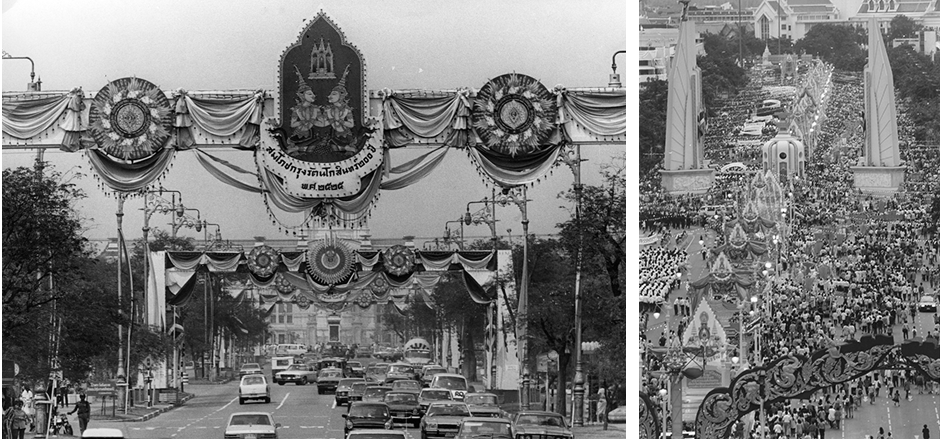 Bangkok took on a festive spirit for the Rattanakosin Bicentennial and the 60th birthday of His Majesty the King.
Bangkok took on a festive spirit for the Rattanakosin Bicentennial and the 60th birthday of His Majesty the King.
The year 1987 brought another round of pomp and grandeur as the country celebrated His Majesty the King’s fifth cycle (60th) birthday. Among the events was the Royal Barge Procession to present Kathin Robes to monks at the Temple of Dawn, and four days of royal engagements from December 4-7 that included a Grand Audience in a purpose-built pavilion in Sanam Luang.
The government also declared 1987 as Visit Thailand Year to mark this auspicious event, igniting a major tourism campaign that would put Thailand on the map of the world’s top travel destinations for years to come.
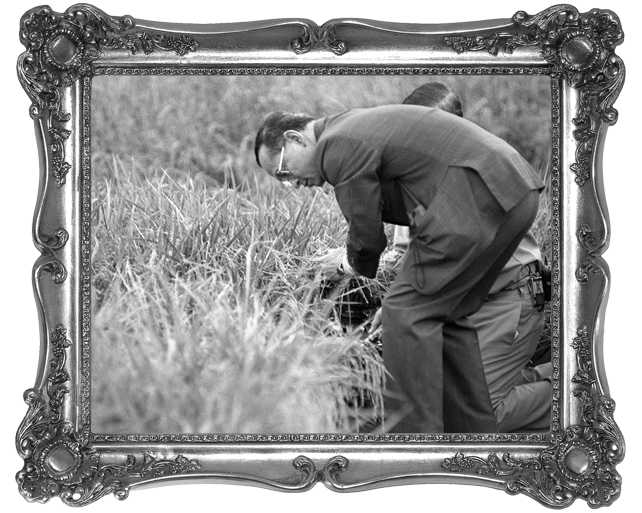
His Majesty the King’s Chaipattana Foundation aimed to help farmers, the backbone of the country, improve yields and become self-reliant.
The following year, on November 13, 1989, His Majesty became the longest reigning monarch alive, followed successively by Prince Rainier III of Monaco, King Baudouin of Belgium and Queen Elizabeth II of Great Britain.
At the age of 60, most people would be looking forward to a life of leisure and retirement, but not His Majesty the King. After decades of development work carried out to help alleviate the problems of the people, His Majesty the King knew there was still a lot more to be done.
Realising that the government was hindered by bureaucracy and budget constraints, making it difficult to provide timely help for the people, particularly in times of crisis, he established the Chaipattana Foundation. Officially registered on June 14, 1988, the foundation was set up to help further national and social development in conjunction with government and private agencies. The foundation originally targeted farmers who formed the backbone of the country, aiming to help improve yields through sustainable means that would yield long-term rather than immediate results that would eventually allow them to be self-reliant. Simplicity and sustainability were the key words in every Chaipattana project.
Agriculture headed the list of projects undertaken by the Chaipattana Foundation. Soil conditions such as soil acidity or salinity had always posed ongoing obstacles for farmers and their crops. His Majesty’s experimental stations have continued to find ways to combine technology with ancient folk wisdom which is then applied to the problem areas, such as the use of marl and water to dilute the acidity, and using lignite ashes, or the growing of Sunn Hemp (Crotalaria Juncea L) and legumes to improve soil conditions after a rice harvest.
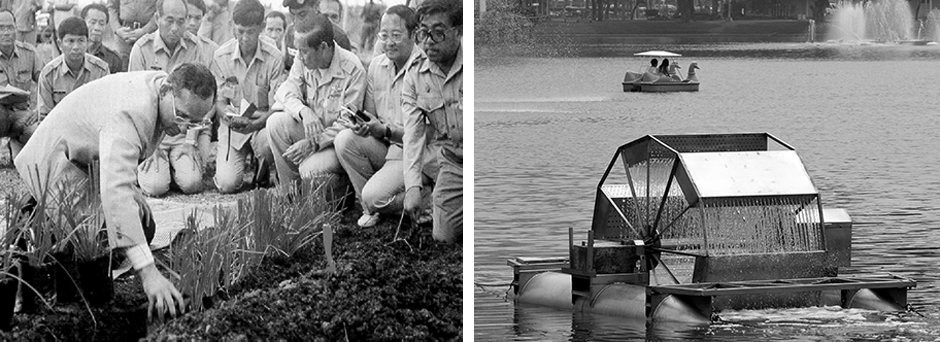
The New Theory of farming, vetiver grass and the Chaipattana Aerator were just some examples of His Majesty’s innovations for the country.
The foundation's work also still covers environmental quality improvement, the sustainable management of natural resources, social development and cultural conservation, energy development, particularly renewable energy, natural disaster relief and recovery, and international collaboration and training. With urban problems becoming more prominent in the 1990s, the foundation gradually came to encompass such problems as flooding, air pollution, waste water and traffic as well.
Several projects have now become household words, such as the Kaem Ling (Monkey Cheek) project to prevent flooding. The concept was simply to divert flood water into storage areas and slowly allow it to drain, like a monkey that stores bananas in its cheeks first, and chews and swallows them gradually.
The lowly ya faek (vetiver grass) took on new meaning when His Majesty introduced this long-rooted grass as a natural barrier against soil erosion. The long roots hold the soil together, the grass protects the topsoil, and can also be used to feed animals.
The Chaipattana Aerator, a low-speed surface aerator that helps to treat waste water, was His Majesty’s invention that was granted a patent in 1993, making him the only monarch in the world to have received this honour. It was also recognised by the Belgian Chamber of Inventors during the 49th Brussels Eureka 2000 in Belgium for its “widespread use and beneficial to the development of the quality of life and environment worldwide”.
In its statement, the International Committee noted: "The King of Thailand is a developer king who possesses high diligence, ingenuity, and exceptional vision, in working arduously for the benefit of his subjects. He utilises simple technology in his inventions which can be applied widely throughout the world."
The following year, at Brussels Eureka 2001, His Majesty's royal rainmaking project, and his book Royal Rainmaking Textbook, which he created himself on his computer, were awarded with the Gold Medal with Mention. The royal rainmaking project had been implemented successfully since 1969, was officially set up as the Artificial Rainmaking Research and Development Project within the Ministry of Agriculture and Cooperatives in 1971, and was registered with the World Meteorological Organisation in 1982. The technology has been requested by several drought-ridden countries such as Indonesia, Bangladesh, China, Malaysia, the Philippines, Singapore and Sri Lanka.
After years of working with and for the people, His Majesty was all the more convinced that self-reliance and sustainable development was the only way for the country to achieve stability, even through the unbelievable economic growth in the early 1990s. The concept of self-sufficiency had been touched upon in His Majesty’s speeches for the past 20 years, but it was only after the great economic meltdown in 1997 that the concept was properly formulated and promoted.
In His Majesty the King's birthday address given on December 4, 1974, he said: "I ask all of you to aim for moderation and peace, and work to achieve this goal. We do not have to be extremely prosperous … If we can maintain this moderation, then we can be excellent."
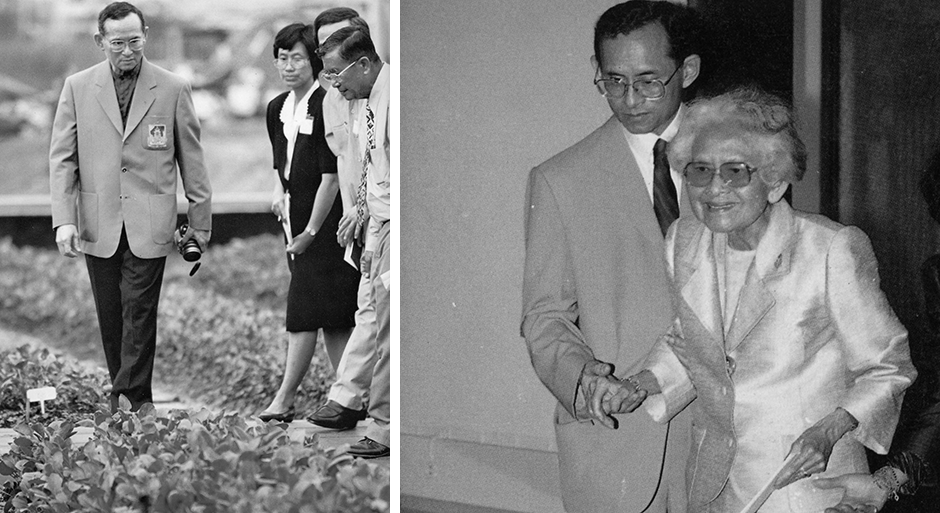
'She taught me everything,' His Majesty once said of HRH The Princess Mother.
The economic crisis was proof of His Majesty’s wisdom. He had always stressed the need to build the overall economic foundation and stability of the country, and ensure the subsistence of the rural people, before going on to a higher level of development or industrial growth.
The Chaipattana Foundation website provides this concept breakdown.
The Philosophy of Sufficiency Economy and its Three Pillars:
• Moderation: Sufficiency at a level of not doing something too little or too much at the expense of oneself or others, for example, producing and consuming at a moderate level.
• Reasonableness: The decision concerning the level of sufficiency must be made rationally with consideration of the factors involved and careful anticipation of the outcomes that may be expected from such action.
• Risk Management: The preparation to cope with the likely impact and changes in various aspects by considering the probability of future situations.
Decisions and activities must be carried out at a sufficient level depending on two conditions:
• Knowledge, comprising all-round knowledge in the relevant fields and prudence in bringing this knowledge into consideration to understand the relationship among the field so as to use them to aid in the planning and ensure carefulness in the operation.
• Virtue to be promoted, comprising the awareness of honesty, patience, perseverance, and intelligence in leading one’s life.
Yet the beauty of the sufficiency theory is that it can, and should, be applicable to everyday life as follows:
• How to lead a life in accordance with the Philosophy of Sufficiency Economy
• Adhere to economising by cutting down expenses in all aspects and forego extravagances in leading one’s life.
• Adhere to pursuing one’s occupation with decorum and honesty.
• Stop contending for beneficial gains and using harsh methods in commercial competition.
• Never cease to find a way to escape hardship by attempting to gain knowledge in order to increase one’s income to the point of sufficiency.
• Leading one’s life by following the good path, avoiding the bad, and adhering to religious principles.
In relation to the agricultural sector, His Majesty formulated what was known as the New Theory, which would help farmers become self-sufficient and extract themselves from the vicious cycle of debt as a result of large investments with the hope of high returns, against the real risk of price fluctuations and manipulations.
The New Theory works according to a 30:30:30:10 formula. According to this theory, farmers with a minimum plot of land should allocate 30% of the land to ponds or reservoirs, which is used to store rainwater during the rainy season and supply water to crops during the dry season. Fish can also be raised for food in the ponds.
The next 30% is allocated to rice fields to feed the family without the need to spend money on food.
Thirty per cent is then set aside for fruit orchards, vegetable and herb gardens for daily consumption, while the final 10% becomes the living quarters for the farmer and his family as well as a certain amount of farm animals, and for roads and other structures.
There are certain conditions, however. An average family needs at least 5 rai to grow enough rice for a year’s consumption, so the average farm would be approximately 15 rai. Rice should only be grown during the rainy season, in order to conserve water during the dry season for other use or substitute crops.
The format allows a small-scale farmer to subsist on his own harvest, with whatever left over to be sold as income. It allows the local community to attain a certain degree of financial autonomy, which is necessary before it can consider entering the market economy.
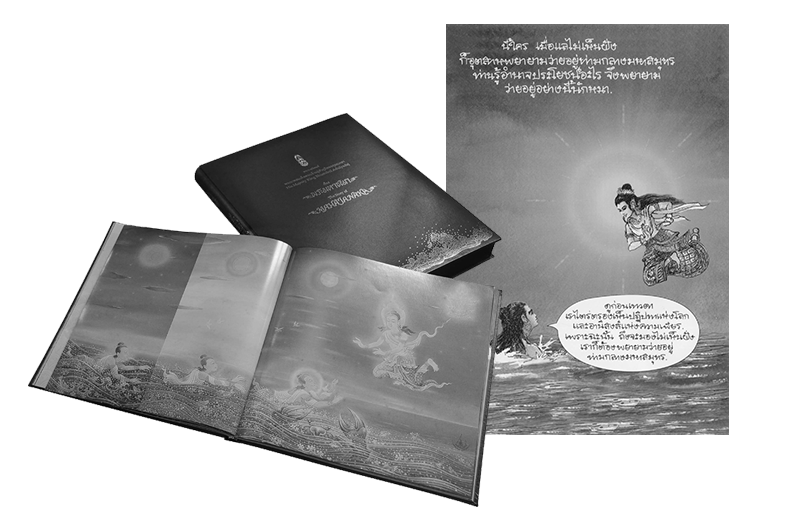 His Majesty’s book, ‘Mahajanaka’, in different forms.
His Majesty’s book, ‘Mahajanaka’, in different forms.
Though he did not show it, His Majesty must have been devastated when HRH the Princess Mother passed away on July 19, 1995, at Siriraj Hospital at the age of 94. She had been a rock in his life, instilling in him his sense of responsibility and humanitarianism, as well as his principles of self-reliance and moderation.
"She has taught me everything," he said to a French journalist in 1992.
In 1996, His Majesty the King published what was to be the most popular and visionary of his body of literary works, The Story of Mahajanaka. His Majesty’s previous translation works included Small is Beautiful: Economics as if People Mattered by EF Schumacher, said to be the source of His Majesty’s inspiration for his sufficiency economy , Tito (the biography of former Yugoslavian president Josip Broz Tito, by Phyllis Auty), and Nai In Phu Pid Thong Lang Phra from A Man called Intrepid by William Stevenson.
The Story of Mahajanaka had been two decades in the making, the bulk of that spent reading the story of Mahajanaka in the Pali canon of the Buddhist Tipitaka scriptures. His Majesty the King wrote the story in Thai and English, with illustrations by leading Thai artists, many of them national artists.
The story underlined the merit of perseverance, as exemplified by King Mahajanaka who was shipwrecked and had to swim for seven days and nights until the goddess Mani Mekhala took pity on him and saved him. The wisdom of King Mahajanaka helped pull the country through the pitfalls of ignorance, greed and excess, and its publication just as the Thai economy crumbled was coincidental but timely.
"…one has to persevere to achieve an aim," wrote His Majesty in the introduction.
That all but sums up the greatness of His Majesty the King himself.

His Majesty the King’s personalised New Year greeting cards always featured his beloved pet, Tongdaeng, and her brood.
In 2002, the Thai public were overjoyed to read a book written by their King about his beloved pet dog, a street dog named Tongdaeng. The book – as well as the illustrated version that was published in 2004 – was more than just anecdotes about a dog, but was considered a parable on the subject of love, respect and loyalty as symbolised by Tongdaeng’s relationship with the King. The story also opened up a whole new perspective of the King’s mysticism and allowed the public a glimpse of His Majesty’s private life.
Tongdaeng showed the King in all his down-to-earth simplicity, in an era when consumerism and displays of wealth were dominating Thai society. When the well-to-do were paying high prices for imported pedigrees, His Majesty showed how a local street dog could be just as loyal, affectionate and well-trained. Images of His Majesty and Tongdaeng showed His Majesty’s private quarters to be simple rather than ostentatious as one would expect a palace to be. His Majesty’s personally designed New Year greeting cards to the people always featured his favourite pet seated beside him. Tongdaeng served to bring the monarch closer to his people at a time when his public appearances grew less and less frequent.
Thailand was the centre of focus in the international community in 2006 as the country celebrated the 60th anniversary of His Majesty the King’s Accession to the Throne. On December 8, 2006, His Majesty the King, accompanied by Her Majesty the Queen, appeared on the balcony of Ananta Samakhom Throne Hall after the Grand Audience and acknowledged the crowd that thronged the Royal Plaza and Ratchadamnoen Nok Avenue, all dressed in yellow, the colour of the monarch, and waving flags. It was an image that brought tears to many as they showed their love and respect to their beloved King.
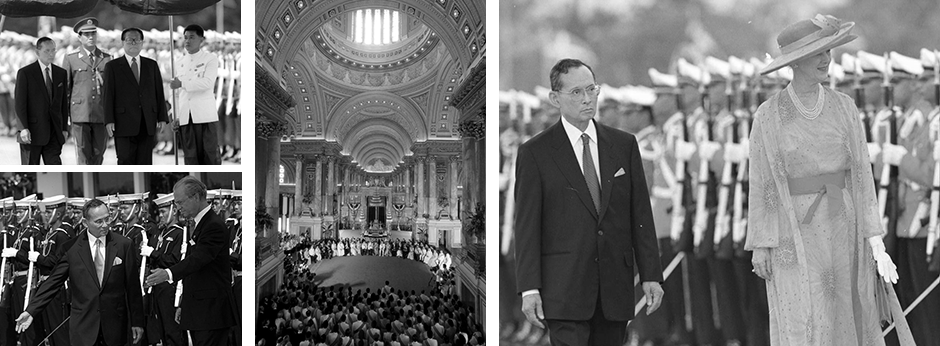 The celebrations to mark the 60th anniversary of His Majesty’s accession to the throne was attended by monarchs from around the world, culminating in a rare group photograph in the splendid Ananta Samakhom Throne Hall.
The celebrations to mark the 60th anniversary of His Majesty’s accession to the throne was attended by monarchs from around the world, culminating in a rare group photograph in the splendid Ananta Samakhom Throne Hall.
Taking part in the celebrations and to personally present their best wishes were a total of 13 monarchs from around the world, while another 12 sent representatives to attend the festivities. The group photograph, taken in the magnificent interior of Ananta Samakhom Throne Hall, is considered an historic image with the most number of the world’s monarchs and royal representatives ever taken together in one place at one time. Yet such was the feeling of love and respect that the world’s royal families felt for His Majesty the King, for his longevity, his dedication and sacrifice towards his people and his country.
The royal guests were also invited to view the spectacular Royal Barge Procession held especially for this grand occasion, seated in the Royal Thai Navy Auditorium opposite the Grand Palace. On the final day of week-long celebrations a banquet was served in Borommaratchasathit Maholan Hall, the Grand Palace.
The following year brought new concerns for His Majesty, however, as his elder sister, HRH Princess Galyani Vadhana, was hospitalised for abdominal cancer. She passed away on January 2, 2008, and the royal cremation ceremony was held on November 15, 2008, providing a truly solemn and magnificent farewell to a sister to whom His Majesty had been so close since childhood.
His Majesty’s health suffered setbacks as a deep fever required the King to be hospitalised at Siriraj Hospital in September 2009, beginning a lengthy stay that would last for four years. This was also the period of great political divide within the country, with the red shirt protests at its height in 2010 resulting in numerous deaths and arson that all but shut down the city of Bangkok.
Bangkok was besieged again the following year, not by protests or arson, but by floods that were triggered by numerous storms that hit Thailand during the monsoon season, with much of Bangkok’s suburbs as well as surrounding provinces being inundated for approximately four months.
From his hospital bed, His Majesty the King would demand to be consistently updated on flood issues. Even with his own health at risk, His Majesty had the well-being of his people at heart, and he continued to work on solutions to the flood problems.
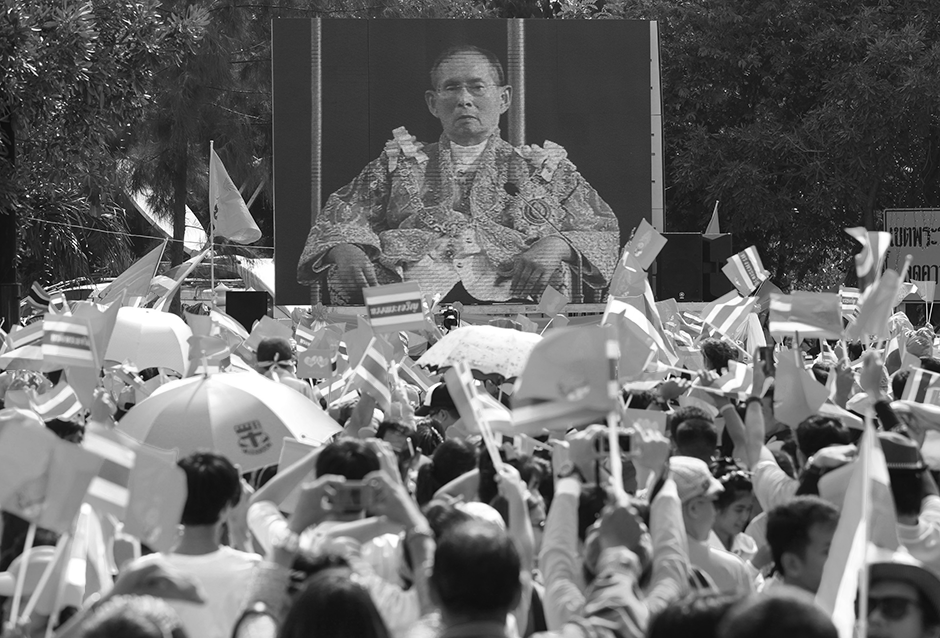 Despite his frail health, His Majesty the King continued to work for the bene t of his people.
Despite his frail health, His Majesty the King continued to work for the bene t of his people.
The year 2011 should have been another year of celebrations, as His Majesty reached an auspicious milestone, his 7th cycle (84th) birthday. However, His Majesty’s frail health, and his concern for the plight of his people as a result of the floods was apparent in his Grand Audience at the Grand Palace when His Majesty appeared in a wheelchair, and gave a speech, referring to his own pilot projects on water management. “The water projects I have discussed are only suggestions, not orders,” he remarked, referring to the Monkey Cheek project amongst others. “But if the projects are beneficial and cost-effective, please implement them.”
While still in hospital, His Majesty held meetings with the prime minister and members of the Strategic Formulation Committee for Water Resource Management (SCWRM) who reported to His Majesty on the progress of flood control measures, while His Majesty would offer his suggestions, as he has always done. Deforestation and greed was partly to blame for the great floods, cautioned His Majesty. He encouraged the planting of mixed forests which would provide lumber, edible produce as well as water absorption from the deep roots.
The committee also proposed flood mitigation projects based on His Majesty’s concepts given during the previous floods of 1995 when he indicated that excess floodwater should be diverted to natural floodways in the eastern and western parts of Bangkok and quickly drained out into the sea.
With His Majesty to show the way, the government soon implemented the Monkey Cheek concept in the Thung Makham Yong project in Ayutthaya province. The Thai public were more than overjoyed when His Majesty the King, accompanied by Her Majesty the Queen and HRH Princess Maha Chakri Sirindhorn, made a trip to Ayutthaya in May 2012, His Majesty’s first trip upcountry in three years, to inspect the royally-initiated project which would help to store water for use in the dry season and ease flood problems in the rainy season.
A few months later, in July, the royal group travelled by river to the Royal Irrigation Department head office in Samsen district, to officially open – via remote live broadcast - five royally-initiated water catchment projects, namely the Khun Dan Prakan Chon Dam in Nakhon Nayok, Khwae Noi Bam Roong Dan Dam in Phitsanulok, Payang Bhumipat water tunnel in Kalasin, Thoranit-Narumitr Water Gate in Nakhon Phanom and Uthokvibhajaprasid Water Gate in Nakhon Si Thammarat.

Finally, after four years under the close supervision of physicians, His Majesty the King left Siriraj Hospital for Klai Kangwon Palace in Hua Hin, which had become like a second home to His Majesty during the later part of his life. And it was here, for the first time during the long reign, that His Majesty’s birthday ceremonies – from the Grand Audience to the Trooping of the Colours – were held in December 2013 instead of the Grand Palace or Ananta Samakhom Throne Hall in Bangkok that had always been the tradition.